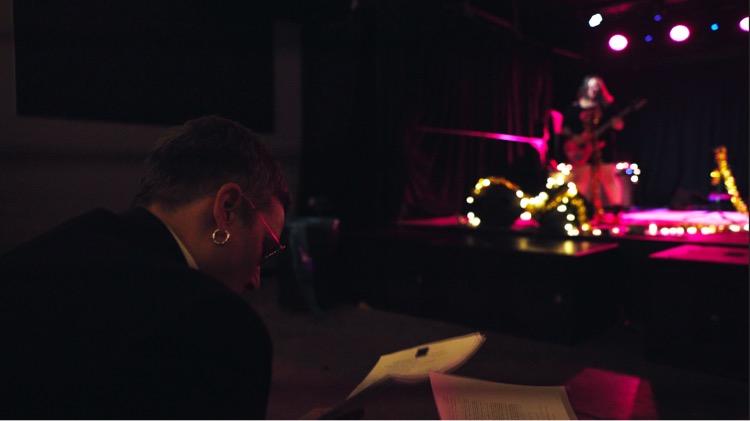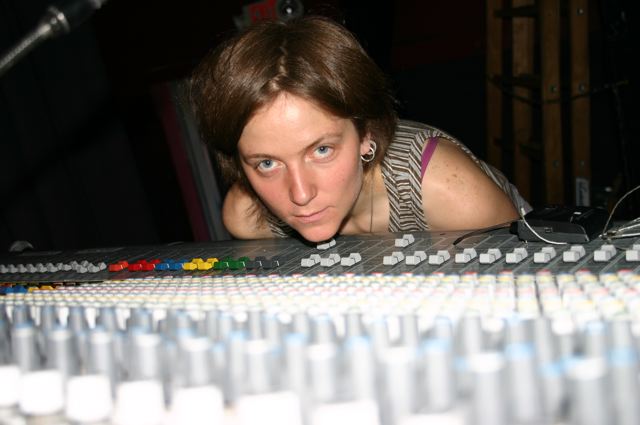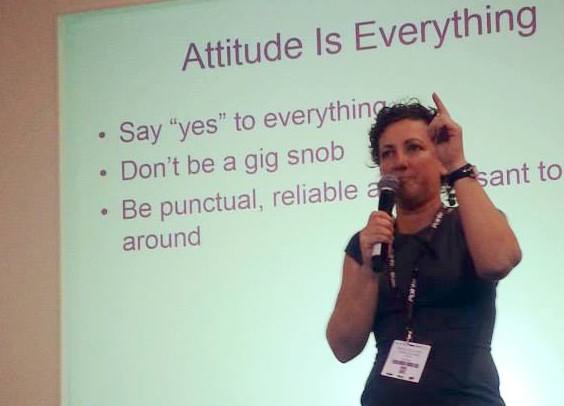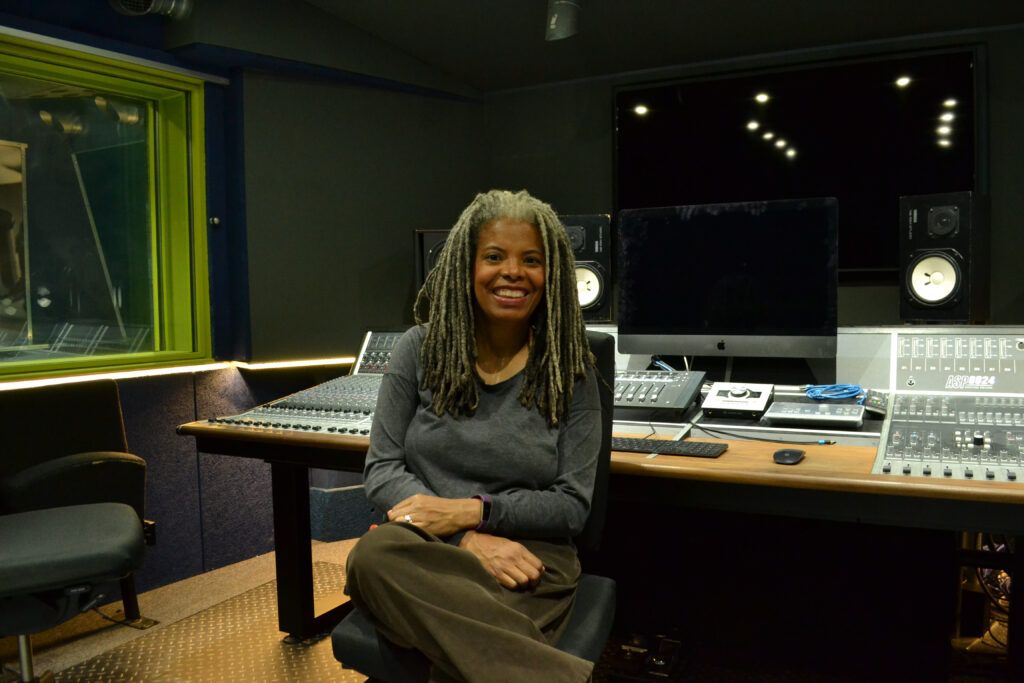Jen Gilleran was born and raised in New York. She studied voice, tympani, and violin at Sarah Lawrence College from a young age and moved to the Lower East Side at 18, immersing herself in the avant-garde scene during one of the most thriving periods in NYC history. She studied conga and Latin-jazz with Frankie Malabe and tabla with Misha Masud and Pandit Samir Chatterjee. Through it all, she attended countless concerts in all genres.
She played percussion for several songwriters and was the drummer for Gregory Alan Isakov, recording, performing, and touring for ten years. Her setup took many forms, from large old resonant Ludwigs to cajon and hand percussion in an exploration of texture and melody that drew on all the subtle and epic music she had experienced.
Family illness brought Jen and her wife to Seattle where she entered a new kind of boot camp. It was here that she furthered her formal education in audio engineering and production, session playing, arranging, teaching, and coaching. After a year of interning with Seattle legend Martin Feveyear, she was asked to join Earwig Studio’s owner Don Farwell as Assistant where she has been ever since. She currently mentors women in the city who are interested in learning the field.
Gilleran will be teaching in Seattle’s first Certificate for Audio Engineering led entirely by womxn and BIPOC at North Seattle College in early 2022. She is also a contributor to Gear Fanatix, a site for underrepresented voices in audio.
How old were you when your first started getting seriously into music?
My parents are all professional classical musicians so pretty much in the womb and I was expected to play music when I popped out.
You’re a vinyl enthusiast – tell us about a recent purchase! What do you like about the sound?
Billie Elish’s new album. She and Phineas both create beautiful textures and her feel kills.
What was it like growing up in the New York music scene?
Thrilling and hard work and fun and humbling and relentless learning
Which artists inspired you growing up: from writers and poets to musicians
My mom was a choral director, so I was recruited into the church choir at a really young age. My mom has a super-sensitive ear and received her Master’s in organ and conducting from Sarah Lawrence College. The pieces she chose for the choir were really challenging and I’m in love with Vaughn-Williams, Ned Rorem, Stravinsky, Healey Willan, John Tavener. My step-father is a prodigy violinist from Seoul, Korea, and was a founding member of the string quartet-in-residence at Sarah Lawrence College. I went to more quartet concerts than I can count. I loved it, especially Bartok string quartets; Dvorak’s American String Quartet; any Mozart (ever). In high school, my best friend’s parents were also artists, but the vibe of their home was something I had only read about – bohemian, free-thinking, hilarious, parties of Germans and Russians and Croatians all bundled around the dinner table with strong opinions, big laughter, and deep respect for discourse especially about art. I got really into Jessica Lange after watching ‘Frances” a million times and therefore Sam Shephard and his plays which led to a deep dive into Edward Albee, Tennessee Williams, Lorraine Hansberry, and Eugene O’Neil which then turned me onto the screen adaptations of their plays which then started my obsession with Elizabeth Taylor, Anna Magnani, Marlon Brando, Elia Kazan, Orson Welles, Sidney Poitier, etc.
I was simultaneously falling in love with writing and had an English teacher that saved my life with Virginia Woolf’s journals as well as with Adrienne Rich, Alice Walker, Toni Morrison, Louise Erdrich, Elaine Showalter, Flannery O’Connor, and Maya Angelou. In the high school hallway,s I would pass her pages of my rambling mind-blown thoughts under the constant threat of being seen by my f-cked-up peers.
I started studying drums early on and at 15, was really into tympani and was accepted into the Sarah Lawrence orchestra with my step-dad as concertmaster. Drumkit didn’t really start until 14 and I was crazy about John Bonham and Stewart Copeland, Jimi Hendrix, and Mitch Mitchell. I was hooked from note one of Duke Ellington’s and John Coltrane, Elvin Jones, Miles Davis, Tony Williams, Ella Fitzgerald. My drum teacher was a big jazz head and would push me to do really textural solos for the school concert – which all the asshole boys thought was really weird, which is always a good sign.
When I was 19 I started lessons with the late great conguero, Frankie Malabe who turned me onto Cuban and Puerto Rican artists and music. I was buddies with a guy who owned a drum store in Nyack, NY and he got me into every amazing jazz venue in NYC. He also had drum clinics in his store, and I got in for free. I had dinner with Joe Morello and heard him shoot the sh-t behind his black glasses. I sat about 5 feet from Mongo Santameria at the Blue Note and could almost touch Tony Williams’ canary yellow Pearl kit at the Village Vanguard. I saw Terri Lynn Carrington at Sweet Basil; Joe Lovano and Paul Motian at the Vanguard; Dave Valentin at the Blue Note. Tito Puente at the Village Gate where every Monday night they had the Salsa Meets Jazz series that I would attend constantly. By then I was living in NYC, so everything just exploded for me. It was a rough time with my family, and I credit my best friend, Ilya [Chaiken, documentarian], Frankie, and the Lower East Side with saving my life.
At about 22, I started an eight-year study of tabla, and again, because of where I lived I got to witness so many astounding performances – from small apartments to recording studios like Master Sound in Queens. I was a founding member of this crazy band called ‘Dim Sum Clip Job’ which became a darling of John Zorn’s and we had the honor of opening for his ensemble performing ‘Pueblo’ with Marc Ribot. This led to many, many gigs watching Zorn’s game pieces at the Knitting Factory as well as his groups Naked City, Painkiller, and my favorite, Masada. There were a bunch of us Knitting Factory kids that followed Bill Frisell, Joey Baron, Dave Douglas, Myra Melford, Anthony Coleman, Fred Frith, Robert Quine, Ikue Mori, Cyro Baptista, Zeena Parkins, Ruben Radding’s Myth Science. I played tabla and framedrums in the band ‘Pharoah’s Daughter,’ which was led by a woman raised in the Jewish Orthodox community and outcast as she performed traditional Hebrew songs with Middle Eastern instrumentation and rhythms at the Knitting Factory. We toured in England and were met with varied forms of rejection or joy. We played in an old, converted bank in Morcombe where the sea spilled over into the streets and Scotland was in view on the horizon. I went from there to Amsterdam and Italy and learned some Tarantella rhythms as I accompanied a woman who played traditional folksongs from Abruzzo – the region my mother’s side of the family is from. We performed a few times and a year later she joined me at the Knitting Factory.
In my late 20s, I tagged along with an ex who was selected to dance in Min Tanaka’s company in Hakushu, Japan. We first went to Korea where my ex and two others from the company performed for 3 days at the Gwanju Biennale. During the time they rehearsed, I had free reign of the gigantic museum. It was spectacular. Art from all over the world. My favorite was from Belkis Ayón of Cuba. The dance performance was so challenging for my ex and the other two dancers. The only instruction Min gave them (he was not present) was that they were to improvise to (and on) an installation created from creosote-soaked railroad ties wrapped partially in white canvas that reminded me of the remnants of a washed-up ship. The room was almost entirely Korean and non-English speaking deeply engaged and either totally moved or shouting at the dancers if they didn’t like it. My ex had large welts and splinters that afterward were removed gently by random older Korean women who surrounded her and shook their heads. We then traveled to Min’s farm and for six weeks I joined at 4:30 every morning to harvest and transplant his vegetable fields after which rehearsals began. I was invited by Min to watch rehearsals and sometimes he asked me privately for feedback. The piece was based on the works of Edgar Allen Poe with a libretto written by Susan Sontag. I had the rare opportunity to watch his process. Sometimes Min would shout ‘WHY do you move?!?!’ and it is a question I often refer to when I produce.
I lived in Boston for 2 years around then, returned to NYC and the following year went to Boulder, Colorado for what I thought would be a summer. I stayed for 10 years after meeting singer-songwriter Gregory Alan Isakov who asked me to join his band. It was cello, violin, acoustic guitar, harmonica, and myself on drums. I felt a lot of space for melody without a bassist and I approached it like tympani. We worked very closely on two albums of his, plus toured and performed regularly. He started getting more popular and although it was fun, ultimately, I missed the intimacy of the music and the process. I loved the farmland and the space in Colorado and I loved being in a band until I didn’t. I loved touring until I was broke too often. I loved performing until I felt like I was performing some older version of myself. And so, I quit and moved to Costa Rica for 6 months where I got to play a few shows with Robert Dean of “Japan’ and Sinead O’Connor fame. During the rainy season in the rainforest. Man, it was gorgeous, but it was so lonely and really cold! The isolation was challenging but I had taken my snare, my hats, a ride and a cajon, and I practiced a lot. I even taught some kids in town. The music scene was so slow, and I knew this wasn’t a permanent thing. Once a family member became seriously ill my wife and I headed to Seattle to help, and I’ve been here for over 10 years now.
You enjoy adding sounds to your mixes; what is something unusual you’ve added that you felt added to a song?
The Bainbridge ferry. Freight trains. Tires on cobblestone. Hands rubbing together (a nod to David Lynch). Tympani through fx. Tines of a toy piano through fx. I make my own instruments from collected old metal or tools or parts of things left for dead.
What was your journey to audio engineering?
After the long story above and after leaving the Colorado band, I knew whatever I did next had to be something that I could lead, and I didn’t want to be at the mercy of touring or someone else’s decisions. So, I went to the University of Washington and got a scholarship for the audio engineering certificate program. For a year after that, I interned for Martin Feveyear and then grabbed the opportunity of assisting Don Farwell at Earwig Studio when he offered it. Best choice EVER.
OK, tell us about your home studio! What is your setup like and how is your workflow?
I have two UAD Apollo interfaces (an 8 that I upgraded with a Thunderbolt 3 card and a x8); a UAD Satellite; an Eventide H9000, a 24 track Rascal Audio ToneBuss summing mixer; a pair of Adam 7x speakers, a few amazing fx pedals and about 5 external hard drives. I track at Earwig and edit in the box. Lately, I’ve chosen to give Don the mixes after some arranging and editing because I know my limitations, and he is a f-cking wizard.
You assist Don Farwell at Earwig Studio. What has this experience been like?
Don is such a beautiful guy. I am one of many to say that. What others may not know is that he is one of the best teachers. He is such a master and is constantly inspiring me and encouraging me. The studio is a deeply beautiful space. There is some serious sh-t going on. Everyone who records there feels it. And I feel so familiar with it now and so close to its history. I just love Earwig and I am so completely grateful that Don let me into his vision. I’d kill for that guy!
Do you have a favorite aspect of the job as far as recording, producing, or mixing?
I strive to be on Don’s level of mixing, and I will not stop trying because I really enjoy it. I feel totally confident engineering at Earwig and even more strongly confident about getting the best performance out of those that trust me to produce. I can be relentless. But my goal is to get the absolute best from people. Often it gets emotional and always feels intimate. We also laugh our asses off. I’m also goofy as fuck. But I am dead serious about music and about inviting the motherf-cking ancestors into the studio. No joke.
Have you ever experienced any sexism as a woman in the industry?
Absolutely. Since Day 1.
As a girl in 3rd grade who made a pact with my friend to raise our hands when asked to sign up for drum lessons. My friend chickened out. My hand was up there alone. The boys were relentless. F-ck ‘em. I learned to play a drumroll before lesson 1. I was put at the head of the room to demonstrate how to do it. I took that attitude into the future. It hurt like hell when every drum teacher -except the one woman – hit on me. One cornered me before a show in his hotel room. I was devastated. Nothing like rejecting a ‘master’. Needless to say, it was so mortifying that I didn’t continue, and he didn’t give a shit.
I’m grateful (?) that I at least got a few years out of them at least before they pulled that sh-t. And, when I was the only woman in Greg’s band, it really sucked sometimes to be treated like I was stopping them from having a good time (translation: let them be freely misogynist). I hated – I mean HATED –when just by virtue of having a female voice they felt like I was their mother when I would try to get their asses to a soundcheck on time. One of the dudes in the band would literally say the same thing – even more forcefully – and no one got pissed. I pulled the van over one day and let them have it. They admitted, through their teeth, that I felt like ‘a nag’. That I reminded them of their mother trying to get their spoiled asses out of bed when they were in HIGH SCHOOL. What?? Man, I don’t miss that AT ALL. I remember consciously letting them all walk on stage before me because I was acutely aware that I had very little power unless they preceded me. I was f-cking validated by them. What the f-ck is THAT?
I’ve been called some horrible sh-t in my life. Sometimes by peace-loving white dudes, that worshipped the music but just didn’t dig that my beauty was not for them. How dare I – right? I got so used to excusing the dudes around me that I just thought it was normal. That I couldn’t find any better. The worst part is that I shied away from working with other women because I felt it would DE-legitimize me as a musician. That is F-CKED. I look back on that time in my life as so much more bullsh-t than the amount of art that was being made. And it was a giant reason that I left. I couldn’t be free or seen or heard for just being Jen. I had to be some f-cking trigger or someone for them to blame for making the room uncomfortable. AND I loved his music (still do). AND I learned a ton musically. AND I loved them all, so it hurt like hell to go. But I felt like I had to choose me. Frankly, I think they were relieved – which is the worst part – although it took them over two years to find a new drummer… so that tells you a lot about how women are valued.
How did you choose to work at Earwig? Any standout moments at the studio?
A great question to follow the last one – Don and I had a great vibe. He is a friggin’ unicorn. He’s so aware of social dynamics and is so smart about human beings. That doesn’t mean he doesn’t struggle, too – of course, he does. But, he is so clear and articulate about what he wants his studio to feel like, which is open and honest, and SAFE. I believe working with him has truly healed me of the bullshit of my past. He welcomed me, he’s a total hardass and expects the best from me, he encourages me and pushes me, and believes in me. And I in him – I am in awe of his talent. He is a true gem and I am so proud to represent. Don RULES.
In the box or analog?
Necessity is the mother of invention. Hybrid unless I have access to all that analog equipment and the time to explore it. Don has some exceptional gear at the studio, but when I’m engineering, I’m not interested in experimenting on people. I’m interested in getting great sounds and letting the players do the work. The great thing about plugins is that you learn on your own time, at home. The great thing about concentrating on the mics and not the outboard gear (too much) is that you learn the f-ck out of how to help people bring it. Plus, I love to dump mixes in the box or out of it onto my MCI JH-110. It calms it down but in a TRex way.
How has COVID affected your job this past year?
It was actually good for me because I was hired to dig deeper with some clients who wanted to explore arrangements, sound design, and performance with me. So, I had good work doing coaching and I love it. But my heart was breaking for bands and I hated seeing Don stressed out.
If you could talk to yourself from ten years ago, what one piece of advice would you tell yourself?
You get what you settle for.
Thank you for your time!



